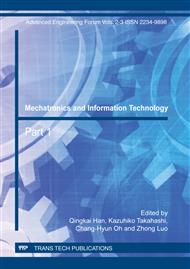[1]
S.M.M. Rahman, R. Ikeura, M. Nobe, S. Hayakawa, H. Sawai, "Weight-perception-based model of power assist system for lifting objects," International Journal of Automation Technology, Vol.3, No.6, pp.681-691, Nov 2009.
DOI: 10.20965/ijat.2009.p0681
Google Scholar
[2]
S. Tashiro and T. Murakami, "Step passage control of a power-assisted wheelchair for a caregiver," IEEE Transactions on Industrial Electronics, Vol. 55, No. 4, April 2008, pp.1715-1721.
DOI: 10.1109/tie.2008.917061
Google Scholar
[3]
H. Seki, K. Ishihara and S. Tadakuma, "Novel regenerative braking control of electric power-assisted wheelchair for safety downhill road driving," IEEE Trans. on Industrial Electronics, Vol. 56, No. 5, May 2009, pp.1393-1400.
DOI: 10.1109/tie.2009.2014747
Google Scholar
[4]
T.Takubo,H. Arai,K. Tanie,T.Arai,"Human-robot cooperative handling using variable virtual nonholonomic constraint," International Journal of Automation Technology, Vol.3, No.6, pp.653-662, 2009.
DOI: 10.1109/robot.2001.933027
Google Scholar
[5]
A. Niinuma, T.Miyoshi, K. Terashima, Y. Miyashita, "Evaluation of effectiveness of a power-assisted wire suspension system compared to conventional machine," in Proceedings of 2009 IEEE International Conference on Mechatronics and Automation, August 9-12, 2009, pp.369-374.
DOI: 10.1109/icma.2009.5246728
Google Scholar
[6]
Y. Koike, J. Kim, S. Duk, "Role of stiffness in weight perception," Japanese Psychological Research, 2006, 48 (3), 174–187.
DOI: 10.1111/j.1468-5884.2006.00316.x
Google Scholar
[7]
J.R. Flanagan and C.A. Bandomir, "Coming to grips with weight perception: effects of grasp configuration on perceived heaviness," Perception & Psychophysics, Vol. 62, No. 6, pp.1204-1219, 2000.
DOI: 10.3758/bf03212123
Google Scholar
[8]
S.M.M. Rahman, R. Ikeura, S. Hayakawa, H. Sawai, "Design and control of a power assist system for lifting objects based on human operator's weight perception and load force characteristics," IEEE Transactions on Industrial Electronics, Vol.58, No.8,pp.3141-3150, August 2011.
DOI: 10.1109/tie.2010.2087291
Google Scholar
[9]
S.M.M. Rahman, R. Ikeura, S. Hayakawa, and H. Sawai, "Design guidelines for power assist robots for lifting heavy objects considering weight perception, grasp differences and worst-cases," International Journal of Mechatronics and Automation, Vol. 1, No. 1, p.46–59, March 2011.
DOI: 10.1504/ijma.2011.039155
Google Scholar
[10]
S.M.M. Rahman, R. Ikeura, H. Sawai, "Design and control of a power-assist robot system for lifting objects based on human's unimanual and bimanual weight discrimination," International Journal of Assistive Robotics and Systems,Vol.11, No.2, pp.11-29, June 2010.
DOI: 10.1109/icma.2009.5246450
Google Scholar


